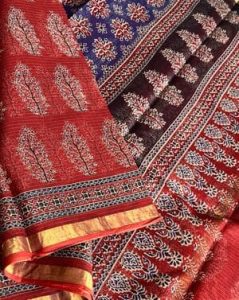Kota Doria Saree
 Kota Doria saree, also known as Kota saree or Kota Dori, is a traditional and lightweight saree that originates from Kota, Rajasthan, India. These sarees are crafted from a unique blend of cotton and silk yarns, which gives them a sheer and airy texture, making them perfect for hot and humid climates. Kota Doria sarees are characterized by their distinctive square-shaped patterns called “khats” and delicate woven motifs. These sarees are favored for their comfort, elegance, and versatility, making them suitable for both casual and formal occasions.
Kota Doria saree, also known as Kota saree or Kota Dori, is a traditional and lightweight saree that originates from Kota, Rajasthan, India. These sarees are crafted from a unique blend of cotton and silk yarns, which gives them a sheer and airy texture, making them perfect for hot and humid climates. Kota Doria sarees are characterized by their distinctive square-shaped patterns called “khats” and delicate woven motifs. These sarees are favored for their comfort, elegance, and versatility, making them suitable for both casual and formal occasions.
Key features of Kota Doria sarees
Fabric: These sarees are made from a blend of cotton and silk yarns. The cotton provides strength and durability, while the silk adds a touch of luster and elegance to the fabric.
Weave: The most distinctive characteristic of Kota Doria sarees is their unique weave, known as the ‘khat’ weave. It involves weaving the cotton and silk threads in a way that creates a fine checkered or square pattern called “khats” or “khatris.” This weave allows the saree to be lightweight and airy, making it ideal for hot and humid climates.
Transparency: One of the defining features of Kota Doria sarees is their transparency. Delicate weave allows air to pass through, making it a comfortable choice for everyday wear, especially during summer.
Borders and Pallu: Kota Doria sarees typically feature thin and contrasting borders, which add a touch of elegance to the overall look. The pallu (the decorative end piece of the saree) often has intricate patterns or designs, enhancing the overall beauty of the drape.
Colors and Designs: Kota Doria sarees come in a wide range of colors, from vibrant and bold hues to subtle pastel shades. The designs can vary from traditional motifs like floral patterns, peacocks, and geometrical shapes to more contemporary and modern designs.
also read about Indian sarees and styles
History of Kota Doria Saree
The origin of these sarees can be traced to the town of Kota, located in the state of Rajasthan, India. The credit for introducing Kota Doria sarees goes to Maharana Shyam Singh, the ruler of Kota during the late 17th century. MaharanaShyam Singh invited skilled weavers from the Mysore region to Kota to impart their weaving techniques to the local artisans. These weavers were known for their expertise in weaving fine cotton and silk fabrics with unique patterns, which eventually became the signature “khat” weave of Kota Doria sarees. The term “Doria” in the name Kota Doria is derived from the Persian word “Dori,” which means thread. This indicates the importance of the fine weaving technique used in creating these sarees.
During the 18th and 19th centuries, the art of Kota Doria weaving flourished under the patronage of the royal families of Rajasthan. The demand for these sarees increased among the nobility and aristocracy due to their lightweight, breathable nature, and intricate designs. Over time, the popularity of Kota Doria sarees spread to different parts of India and even internationally. The skillful weavers continued to experiment with designs, colors, and patterns, making the sarees more diverse and appealing to different tastes and preferences.
Manufacturing of Kota Doria Saree
The making of Kota Doria sarees involves a meticulous and time-consuming process that requires skilled craftsmanship. The art of weaving these sarees has been passed down through generations, and it continues to be a significant cottage industry in the Kota region of Rajasthan, India. Here below are the steps involved in the making of Kota Doria sarees:
Yarn Preparation: The first step is to prepare the yarn that will be used for weaving the sarees. The weavers use a combination of cotton and silk yarns. The cotton provides strength and stability to the fabric, while the silk adds a glossy appearance and enhances the overall beauty of the saree.
Warping: In the warping process, the yarn is wound onto a large wooden frame called the “charkha.” The threads are carefully arranged in parallel to create the length of the saree. The warping process determines the length and width of the fabric.
Dyeing: The next step involves dyeing the yarn to achieve the desired colors. Kota Doria sarees come in a wide range of colors, and the weavers use both natural and synthetic dyes to achieve the desired shades.
Khat Weave: The defining feature of Kota Doria sarees is the “khat” weave, which creates a distinctive square pattern on the fabric. This intricate weaving process involves interlacing the cotton and silk yarns in such a way that it forms a fine checkered design. The weaving is done on a traditional handloom known as the “pit loom,” where the weaver sits on the floor and operates the loom with their hands and feet.
Cutting and Stitching: After the weaving process is completed, the saree is carefully cut and stitched to the appropriate length. The edges are finished with hemming to prevent fraying.
Border and Pallu Design: The border and pallu are an essential part of Kota Doriasaree’s design. These areas are often embellished with intricate patterns, motifs, or zari (metallic threads) work to add an elegant touch to the saree.
Finishing Touches: Once the saree is woven, it goes through a rigorous quality check. Any imperfections or irregularities are corrected, and the saree is then washed and starched to enhance its texture and finish.
The entire process of making a Kota Doriasaree involves a combination of artistic skills, traditional techniques, and attention to detail. It can take several days to weeks, depending on the complexity of the design and the skill level of the weaver. The end result is a beautiful and lightweight saree that exudes elegance and grace, making it a popular choice for various occasions.
also read about Indian sarees and styles



